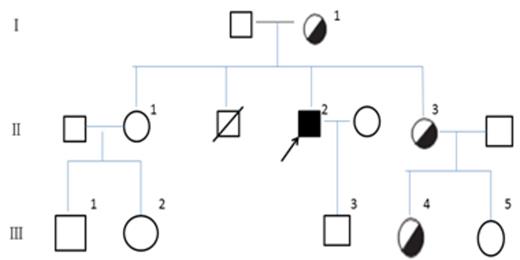X-linked sideroblastic anemia (XLSA; OMIM 301300) is one of the most common inherited sideroblastic anemia, which results from mutations in the erythroid-specific isozyme of 5-aminolevulinate synthase. An amino acid (AA) substitution for arginine at the 452 AA position of the ALAS2 protein is the most frequent mutation, which has been found in approximately one-quarter of patients with XLSA. Here we first report a 3-generation pedigree including 10 individuals with a K156E substitution in ALAS2 gene in China. A 34 year-old man, complained with a microcytic anemia (hemoglobin (Hb) 84 g/dl, MCV 63.8 fl and MCH 16.5pg), increased ferritin serum (3123ng/ml) and transferrin sat (93%), and dyserythropoiesis with 50% of ring sideroblasts (RS) in BM. A diagnosis of XLSA was made. On treatment with 300mg/d pyridoxine and iron chelation therapy with deferoxamine allowed a correction of anemia and reduction of the S-ferritin (1096 ng/ml) in the proband. The peripheral blood samples had been extracted from proband and his family members. All exons containing exon-intron boundaries of ALAS2, SLC25A38 and GLRX5, the promoter region and intron 8 of ALAS2 were amplified and directly sequenced. He is a heterozygous for ALAS2 K156E substituion. The pedigree of the proband's family is shown in Figure 1, while hematologic and iron status data for the family members are reported in Table 1. All 4 heterozygous females from this family showed marginally increased red-cell distribution width (RDW) without phenotypic expression.
Table1
Clinical and hematological features of the pedigree
| Subject . | Sex/age,y . | Hb g/dL . | MCV fL . | RDW% . | Ferritin μg/L . | ALAS2 . |
|---|---|---|---|---|---|---|
| I-1 | F/68 | 115 | 85.2 | 21.4 | 136.7 | + |
| II-1 | F/38 | 128 | 89 | 12.5 | 32.89 | - |
| II-2 | M/34 | 84 | 63.8 | 32.8 | 3123 | + |
| II-3 | F/32 | 136 | 91.9 | 14.8 | 16.8 | - |
| III-1 | M/20 | 152 | 88.2 | 12.1 | 123.6 | - |
| III-2 | F/18 | 123 | 84.8 | 13.3 | 21.84 | - |
| III-3 | M/7 | 144 | 92 | 12.9 | 51.9 | - |
| III-4 | F/10 | 133 | 85 | 13.7 | 16.8 | + |
| III-5 | F/8 | 126 | 81.4 | 18.8 | 31.2 | - |
| Subject . | Sex/age,y . | Hb g/dL . | MCV fL . | RDW% . | Ferritin μg/L . | ALAS2 . |
|---|---|---|---|---|---|---|
| I-1 | F/68 | 115 | 85.2 | 21.4 | 136.7 | + |
| II-1 | F/38 | 128 | 89 | 12.5 | 32.89 | - |
| II-2 | M/34 | 84 | 63.8 | 32.8 | 3123 | + |
| II-3 | F/32 | 136 | 91.9 | 14.8 | 16.8 | - |
| III-1 | M/20 | 152 | 88.2 | 12.1 | 123.6 | - |
| III-2 | F/18 | 123 | 84.8 | 13.3 | 21.84 | - |
| III-3 | M/7 | 144 | 92 | 12.9 | 51.9 | - |
| III-4 | F/10 | 133 | 85 | 13.7 | 16.8 | + |
| III-5 | F/8 | 126 | 81.4 | 18.8 | 31.2 | - |
In summary, this is a novel K156E substitution in ALAS2 gene discovered in a 3-generation pedigree in China. Furthermore, early diagnosis of XLSA allows preventing the complications of the iron overload by chelators or by iterative phlebotomies.
Disclosures:
No relevant conflicts of interest to declare.
© 2013 by The American Society of Hematology
2013


